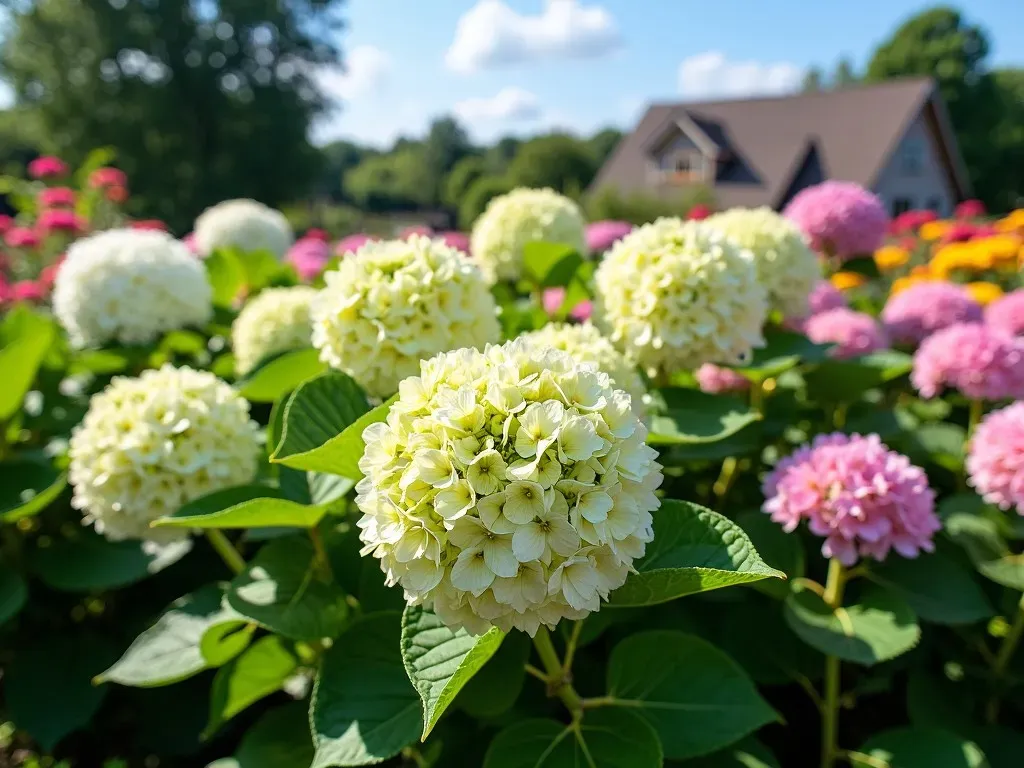The Limelight hydrangea, scientifically known as Hydrangea paniculata ‘Limelight’, is a stunning variety of panicle hydrangea renowned for its spectacular blooms that transition from lime green to soft pink and deep burgundy as they mature. This versatile shrub not only adds elegance and dimension to any garden, but it is also easy to care for and displays impressive durability across various climate zones.
Understanding Limelight Hydrangea
What Makes Limelight Hydrangea Special?
Limelight Hydrangeas are celebrated for their unique flower structures and color transformations. The flowers are initially small, cone-shaped clusters that emerge in a lively lime green shade, later maturing to a creamy white and finally turning to shades of pink and burgundy in the fall. This dynamic color change offers an extended visual appeal throughout multiple seasons.
 hydrangea flower Transition">
hydrangea flower Transition">
Appearance and Size
Typically, the Limelight Hydrangea reaches heights of 6 to 8 feet and spreads about 5 to 6 feet, making it an ideal choice for hedges, borders, or focal points in any landscape design. The sturdy stems support heavy flower clusters, making it a striking feature even in rainy weather.
| Attribute | Details |
|---|---|
| Type | Deciduous shrub |
| Height | 6 to 8 feet |
| Spread | 5 to 6 feet |
| Flower Color Transition | Lime green → White → Pink/Burgundy |
| Bloom Time | Summer to early fall |
| Hardiness Zone | 3 to 8 |
The Perfect Location for Limelight Hydrangeas
Sunlight Requirements
One of the key considerations for planting Limelight Hydrangeas is the amount of sunlight they receive. They thrive best in full sun to partial shade. Ideally, they should receive at least 6 hours of sunlight per day. Hydrangeas may tolerate some shade, but too much can limit their flowering.
Soil Preferences
Limelight Hydrangeas prefer well-drained, rich, loamy soil with a slightly acidic to neutral pH. A good soil mixture will ensure that the plant stays healthy and displays vibrant blooms.
Watering Guidelines
While new plantings require regular moisture, established Limelight Hydrangeas are relatively drought-tolerant once their roots are established. Aim for consistent watering—about 1 inch per week, adjusting for rainfall.

Reference Video
Caring for Limelight Hydrangea
Fertilization
To promote healthy growth and impressive blooms, fertilization should occur in early spring. A balanced fertilizer (e.g., 10-10-10) is recommended, as it provides a suitable nutrient offer to the shrub. Avoid fertilizing late in the season as it may encourage tender growth susceptible to frost.
Pruning Techniques
Pruning is crucial for maintaining the size and health of Limelight Hydrangeas. These shrubs bloom on new wood, which means they can be pruned in late winter or early spring before they bud. Remove the previous year’s blooms and trim back any dead or weak stems.
| Pruning Method | When to Prune |
|---|---|
| Remove Dead Blooms | Late winter to early spring |
| Shape the Plant | Late winter to early spring |
| Thin to Improve Airflow | Late winter to early spring |
Pest and Disease Management
Limelight Hydrangeas are generally resistant to pests and diseases. However, keep an eye out for common issues such as aphids, spider mites, and powdery mildew. Utilize insecticidal soap or neem oil for pest management. Adequate spacing between plants fosters good air circulation, reducing the risk of disease.
Creative Uses for Limelight Hydrangea
Designing a Garden Space
Limelight Hydrangeas can be incorporated into various garden designs. Here are some ideas:
- Hedges and Screens: Create a natural shield by planting Limelight Hydrangeas closely for privacy.
- Mixed Borders: Plant alongside perennials, such as coneflowers or sedums, to add depth to the garden design.
- Containers: Limelight is also suitable for container gardening, providing vibrant blooms even in smaller spaces.

Companion Plants
Limelight Hydrangeas pair well with a variety of plants, enhancing their visual appeal. Some popular companions include:
- Hostas: For lush green foliage that complements the blooms.
- Daylilies: Bright colors and hardy nature work well together.
- Japanese Spurge: Offers a ground cover that harmonizes with higher-growing hydrangeas.
FAQs About Limelight Hydrangeas
How do I propagate Limelight Hydrangeas?
Limelight Hydrangeas can be propagated through cuttings in spring or summer. Use healthy, non-flowering stems, and place them in a damp mixture of peat and perlite until roots develop.
When do Limelight Hydrangeas bloom?
Blooming typically occurs from mid-summer to early fall; flowers can last for several weeks depending on environmental conditions.
Can Limelight Hydrangeas withstand harsh winters?
Yes, Limelight Hydrangeas are hardy and can withstand cold temperatures, making them suitable for USDA hardiness zones 3 to 8.
How do I care for Limelight Hydrangeas in the fall?
In the fall, you should reduce watering, clear away fallen leaves, and apply a layer of mulch to protect the roots during winter.
Where can I find Limelight Hydrangeas for sale?
Many local garden centers and online retailers offer Limelight Hydrangeas. It is advisable to check reputable gardening websites such as Proven Winners for quality plants.
Remember, creating a stunning garden with Limelight Hydrangeas can transform your home landscape, giving it character and charm that appeals to both residents and visitors alike. Embrace the beauty and treat your garden to the elegance of these magnificent hydrangeas!


